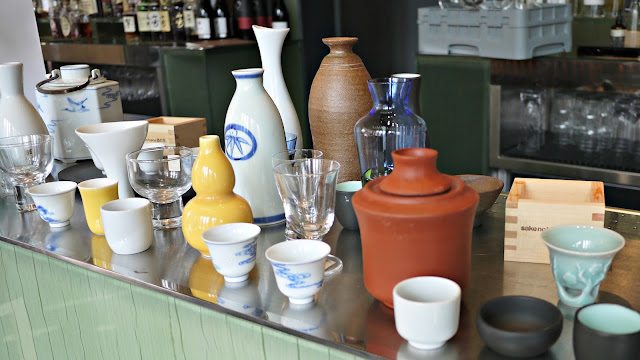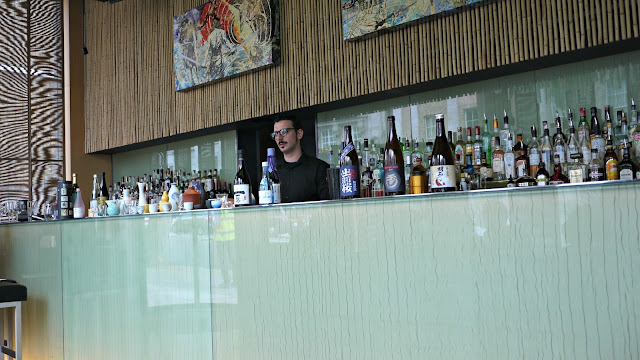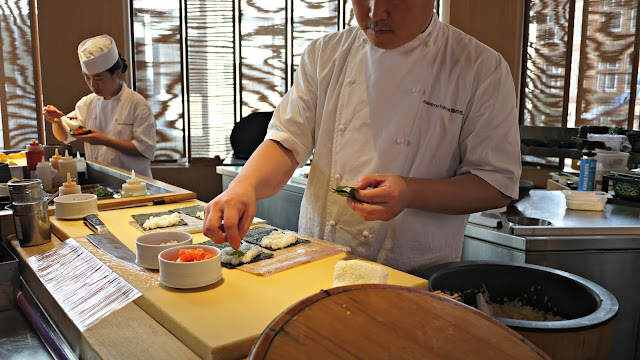Sake is Japanese wine made from rice. I'd tried it previously when I visited Sake no Hana a while back, so when I was invited to come along to their new 'Introduction to Sake' class which involved tasting sake, learning more about them, and then having a delicious lunch with some sake, I didn't hesitate to respond with a huge yes! For the past 6 months or so I've been working with a wine company, and have become increasingly interested in different wines, how they're made, and how they taste. I went to a biodynamic wine tasting last week which was just brilliant, and the sake class was incredibly interesting - I'm loving learning all about these different wines.
I took Henry along with me, and we had a really great time - it was fascinating to learn about the history and origins of the Japanese rice wine. Wine writer for the Independent, Anthony Rose, gave a talk on how sake is made, before we tasted some different types of sake. Sake is pronounced 'Sah-keh', and is brewed, rather than fermented, taking roughly a year to make from start to finish.
 |
| Anthony Rose talking about Sake |
We tasted a number of different sakes including a Junmai and a Honjozo, which are both premium sakes, with the Honjozo being very dry and tasting more 'savoury', and the Junmai being much more earthy and fruity. We also had a Junmai Ginjo, which is a super premium sake, which tasted very smooth and much richer. My favourites were the Sparkling Shirakabegura 'Mio', and the Nigori KamoizumiGinjo, which was a pure rice sake that looked quite milky but tasted beautiful.
 |
| The traditional cups used for drinking sake |
Head Wine Buyer for Hakkasan group, Christine Parkinson, then gave a really interesting talk on the history behind sake, and the type of occasions it is drunk at. The Japanese apparently encourage drinkers to 'get merry', but not too merry, the idea is to enjoy the occasion.
After our sake class and tasting, we went upstairs to the restaurant for lunch with different sake's accompanying the food. The restaurant itself is big, modern and a really great space. The high ceilings, trendy decor and light and airy room made it a very relaxed setting for lunch.
We started with the Red Miso Soup with mushrooms and dumplings, which was deliciously rich, the perfect hearty soup for a cold day.
We tried both cold and warm sakes with the meal. H and I weren't so keen on the warm sakes...to put it bluntly, the first one we had, a Junmai Daiginjo Hoya Kura No Hana, tasted a bit like perfumed bathwater when warmed, however it tasted completely different cold. The second one however, did seem to suit being taken warm rather than cold, that one was the Junmai Kimoto Daishichi.
 |
| The cold Junmai Daiginjo: Hoya Kura No Hana. |
If you sit up at the counter you can watch the chefs making the food. We watched them make the sushi, before it arrived on our table!
I'm not usually a great lover of sushi (understatement - I hate it so much it once made me throw up in the middle of a restaurant in Singapore when I was 13 - classy), as I really don't like the taste of seaweed. However, you couldn't really taste the seaweed in the sushi at Sake no Hana as there was extra rice around the outside and a crispy fried outer layer too. Maybe my taste-buds have just changed as I've grown older, but I ate it all - it was delicious! Apologies to everyone else in the restaurant for witnessing my appalling attempt at eating them with chopsticks, and dropping a piece of sushi in my soy sauce. I've never been able to master chopsticks, no matter how much I try.
After the mains we then had dessert, along with a Sake infused with plum, Umeshu Akashi Tai. It was a very sweet wine, and I'm not overly sure it went with the dessert we had, but it tasted fantastic nonetheless. Umeshu can't always be classed as sake as it's generally a liqueur and made by adding shochu. If it contains sake instead of shochu, then it can be classed as sake.
Dessert was a traditional Japanese dessert called Mochi ice-cream. Mochi is a glutinous rice cake that's pounded into shape. The ice-cream flavours were Green Tea, Vanilla, Mango, Passionfruit and Yuzu (an East Asian citrus fruit). The mango was to die for, I could quite happily eat an entire bowl of it!
Henry and I had a really great day at Sake no Hana, and found it all fascinating. A huge thank you to Christine and Anthony for such a fantastic and interesting introduction to sake! We left very full and just a little bit merry*.
If you love wine, sake, Japanese food and culture, or are even just intrigued by sake after reading this post, take a look at their website, and you can book a place by contacting the reservations team on 0207 925 8988 or reservations@sakenohana.com. The next classes are on Saturday 5th October and Saturday 16th November, from 10:15am-2:30pm, and are £60 per person, which includes the tasting class, a four-course lunch at Sake no Hana, and a gift bag which includes a bottle of sake.
Find me: Twitter | Email | Facebook | Bloglovin | Pinterest | Google+ | Instagram
*understatement
**My friend and I were invited along to Sake no Hana as guests, and received the class and lunch free of charge.
















